Park for Truro (Threemilestone Park & Ride)Highly Commended at Outstanding Achievement Award 2011 for Ecology & Biodiversity and Landscape
|
|
Whole Project Award
Project Team:
Client: Cornwall
Council
Design: Highways
Design Group, Cornwall Council
Construction: Cormac
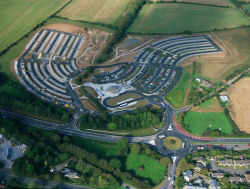 |
|
The project
Truro has a population of 21,000 and attracts 20,000 workers to the city centre each day. Congestion, parking capacity, public transport and pollution issues were identified in the Truro Transport Strategy from which the Park for Truro scheme was born. The establishment of the Park for Truro site was one of a package of measures developed to alleviate pressures on the infrastructure, accentuated by a predicted population increase of 7,000 in 11 years.
With Cornwall being a very rural county the majority of people still rely on their cars to get to work, healthcare, education and leisure. By providing P&R as the final link into Truro, this scheme aims to ease congestion and improve air quality in the historic city. P&R is being carefully targeted at car users in order to ensure that it doesn’t attract those passengers currently using other means of public transport.
Park for Truro is a unique car park combining an excellent and aesthetically pleasing design with environmentally sustainable construction, without compromising functionality. The natural landform and ecology were utilised in the design of this car park, minimising its environmental impact by retaining hedgerows and trees and creating new habitat for native fauna. It is hoped that over time a true biodiversity gain will be achieved in line with the Government’s PPG9 Nature Conservation (replaced with PPS9 Biodiversity and Ecological Conservation).
Site layout and design
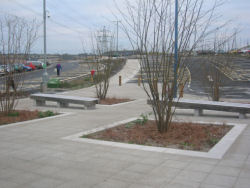 |
|
In stark contrast to what you might expect from a standard car park, Park for Truro has been designed to blend with, respect and enhance the existing landscape and ecology on site, creating an attractive gateway into Truro. It comprises 1,209 spaces; spaces for disabled persons and those with children are clearly signposted and within easy access of the reception building.
Cornwall Council worked with Cornwall Environmental Consultants Ltd as the masterplanners, landscape architects and ecologists to develop the site. The design process looked first to address ecological and landscape issues, with engineering applied afterwards, reversing the usual design process. The main aim was to create a best example of a park and ride design that demonstrates commitment to:
- respecting the environment and quality of the Cornish landscape
- designing a community-integrated park-and-ride facility
- providing for the needs of pedestrians, cyclists and disabled people
- integrating form and function and providing a modern design that can inspire future projects in the South-West and beyond, by working with the existing landscape to blend in with and protect as many local species as possible.
Landscape and ecology
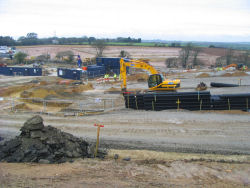 |
|
Working with the existing contours, the parking area was shaped to fit the existing landform creating a bowl-shaped car park with terracing, which minimised earthworks and the need to transport earth to landfill sites.
The majority of the existing hedgerows and trees were protected and retained and these were supplemented with additional planting that included:
- 1.13 ha of native woodland and shrub buffer planting
- 2.26 ha of meadow areas
- 0.85 ha new ornamental planting areas including car park strips and parks
- 2,000 trees
- 30,000 shrubs, many of which will benefit wildlife
- 65,000 plants, including herbaceous plants and climbers
Materials and recycling
A number of recycled materials were used on site to minimise the impact on the environment and this included:
- 18,000 tonnes of road planings taken from resurfacing schemes in Cornwall re-used in the construction of the roads on site
- 500 tonnes of crushed glass used, instead of quarried sand
- 4.5 km of pipe laid on site was made from recycled plastics
- 1.8 km of recycled plastic kerbs were used in place of traditional concrete kerbs
- 15,000 m2 of ecoblock parking bays made from recycled plastics were used instead of tarmac surfacing.
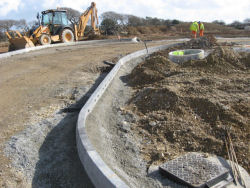 |
|
The Amenity Building
The building has also been designed and built to minimise its environmental impact in terms of both its construction and energy needs and has been equipped with the following sustainable features:
- Solar panels to generate electricity and provide hot water
- Heat from underground sources
- Rainwater is harvested for use in flushing toilets
- A reed-bed filtration system is used to purify waste water from the building before it is discharged into watercourses
- SUDS are used for surface water drainage, including two open storage ponds to improve habitat.
The site includes a number of features to enhance its attractiveness for passengers, such as seating, recycle bins and a boardwalk feature through the site.
Buses
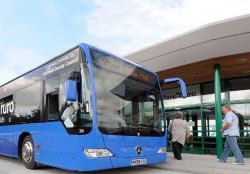 |
|
Park for Truro uses Mercedes Citaro buses that have the latest Euro V low emission engines used in public transport vehicles, which mean that additives are injected into the exhaust to convert harmful gases into the harmless substances nitrogen and water. The scheme is trialling the next generation of enhanced environmentally friendly vehicles (EEV) in Cornwall. The EEV model is the first of its kind in the South-West and in tests against the Euro V model the EEV version emits:
- 80% less CO
- zero hydrocarbon emissions
- 25% less NOx, and
- 91% less particulate matter.
Usage of the site
Since opening on 4th August 2008, Park for Truro park and ride has carried over 208,000 passengers during its first nine months, which has far execeeded expectations. This has resulted in an estimated reduction of 118,000 car trips into the city.
Further Information: www.parkfortruro.org.uk

